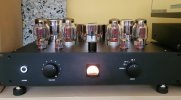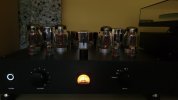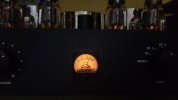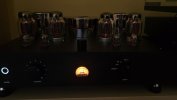OP
- Thread Starter
- #61
One member from DIYAUDIO suggested this article: http://www.tronola.com/html/maximize_tube_life.html that looks at ways to substantially improve the lifetime of the power tubes. I read it and it does make some solid points. In short, it looks at all the reasons why a tube amp would have an arc inside the output tubes and it comes with a practical solution to these problems. The solution presented in the article is to initially apply the 6.3V for the filaments of all the tubes. Wait 30+ and apply the B+ voltage on the input and driver tubes only. Wait another 10s and then apply the B+ to the power tubes. At power off, we disconnect the B+ from the output tubes as quick as possible and then disconnect the B+ from the input and driver tubes.
In my case, I did a test with the PHONO pre-amp removed and I did not have the "thump" at power off. So I tried to increase the output capacitance of the +/-10Vdc regulator. You know, throw some microfarads at the problem . This did not remove the problem completely, but it improved the situation a bit. At power OFF, I see the woofer moving a bit as all the capacitors discharge, and right at the end I hear a smaller "thump". I'll have to wait for the evening to see if there is still that faint light effect (it's too bright to notice during the day). I'll think of a more elegant solution but for now it will have to do. I might want to power the PHONO pre from a separate transformer and regulator but from the same transformer as it is now. I do not want to add another small toroidal inside as I already have two
. This did not remove the problem completely, but it improved the situation a bit. At power OFF, I see the woofer moving a bit as all the capacitors discharge, and right at the end I hear a smaller "thump". I'll have to wait for the evening to see if there is still that faint light effect (it's too bright to notice during the day). I'll think of a more elegant solution but for now it will have to do. I might want to power the PHONO pre from a separate transformer and regulator but from the same transformer as it is now. I do not want to add another small toroidal inside as I already have two  , one for the filament voltage of the input and driver tunes (that gets rectified to have 6.3Vdc) and a second one that is used to generate all the control voltages for the tubes and to power the PHONO preamp.
, one for the filament voltage of the input and driver tunes (that gets rectified to have 6.3Vdc) and a second one that is used to generate all the control voltages for the tubes and to power the PHONO preamp.
In my case, I did a test with the PHONO pre-amp removed and I did not have the "thump" at power off. So I tried to increase the output capacitance of the +/-10Vdc regulator. You know, throw some microfarads at the problem
 ). I also added a rotary switch (non-shorting) on the input of the opamp and now I can see the current through all four tubes. I think that this concludes this project. At least for now
). I also added a rotary switch (non-shorting) on the input of the opamp and now I can see the current through all four tubes. I think that this concludes this project. At least for now 


